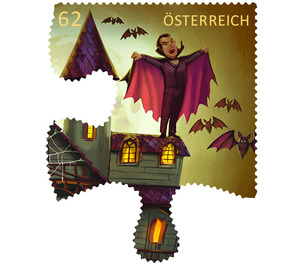Comic brand Puzzle - Austria / II. Republic of Austria 2013 - 62 Euro Cent
Theme: Art & Culture
| Country | Austria / II. Republic of Austria |
| Issue Date | 2013 |
| Face Value | 62.00 |
| Edition Issued | 170,000 |
| Printing Type | offset |
| Stamp Type | Commemorative |
| Item Type | Stamp |
| Chronological Issue Number | 2442 |
| Chronological Chapter | OOS-OE2 |
| SID | 381536 |
| In 14 Wishlists | |
Continuation of the amusing series "comic book puzzle" - the second value of the innovative series, the new special issue block "Halloween", shows a "spooky" theme corresponding to the theme, created by Dominik Gröstlinger. The four self-adhesive stamps together make up the overall picture, but each stamp represents itself, in the form-fitting perforation of a puzzle piece, one of four individual images and a stamp of its own valid stamp value of 0.62 euros each. The word Halloween, in older spelling Hallowe'en, is a contraction of "All Hallows' Eve" and names the "Day before All Saints Day". The reference of Halloween to the realm of the dead arises from the feast of All Saints Day and the following day of remembrance of All Souls, on which the Catholics commemorate their deceased. The origins of the festival: The Scottish religious ethnographer James George Frazer (1854-1941) literally described Halloween in his book "The Golden Bough" in 1922 as an "old pagan funerary feast with a thin Christian cover"; in addition to the so-called "Walpurgisnacht" on May 1, it was the second important festival of the Celts acted. According to Frazer, Halloween has been proven since the eighth century, when Christian synods tried to abolish pagan rites of this kind. The "Encyclopaedia Britannica" also initiates the festival from ancient Celtic customs: on Halloween, therefore, the end of the summer and the entry of the cattle into the stable was celebrated. At that time, according to the faith, "the souls of the dead have returned to their homes". According to the Encyclopaedia Britannica, the festival was celebrated with bonfires on hills and sometimes disguises that served to drive out evil spirits. Also fortune-telling was customary on this date. Halloween used to be celebrated only in Catholic areas of the British Isles, especially in Ireland, while the Anglican Church celebrated the Reformation the day before All Saints Day. From there it came with the many Irish emigrants in the 19th century in the United States and belonged to the customs of this ethnic group. Due to its attractiveness, however, Halloween soon took over and became an important festival in the US and Canada - and quite some time ago in Europe. With the increasing popularity of Halloween but was also from various sides criticism of this "new custom" loud. Thus, in some places, the opinion is held that the old domestic customs are more and more displaced


